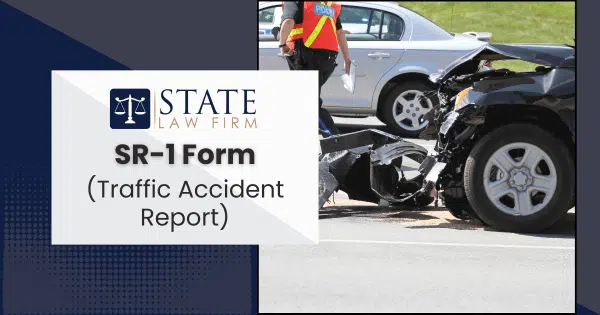If you are in a California traffic crash that meets certain thresholds, the Department of Motor Vehicles requires a separate report called the SR-1.
This is not a police report, nor is it an insurance claim. It is a financial-responsibility report that protects your driving privilege and documents key facts for the DMV.
What the SR-1 Is and When It’s Required
The SR-1 is the “Report of Traffic Accident Occurring in California.” It tells the DMV that a qualifying collision happened and provides the basic information the department needs to determine insurance status and compliance.
You must file within 10 days if any of the following occurred:
- Any person was injured, even a minor injury.
- Any person who has died.
- Property damage to any one person was more than $1,000.
Filing is required even if an officer took a report, even if you have already opened an insurance claim, and even if the crash happened on private property. The SR-1 requirement comes from California’s financial responsibility laws and is separate from everything else.
Who Must File and the 10-Day Deadline
California law puts the duty on each driver who was involved. A representative may file for you, but you remain responsible for making sure the DMV receives a complete report.
Use this quick reference:
| Topic | Rule | Notes |
| Who files | Each driver involved | An insurance agent, broker, attorney, or family member may submit it for you. |
| When | Within 10 calendar days of the crash | Count all days. File immediately to avoid a suspension. |
| Where it applies | Any reportable crash in California | Includes many crashes on private property and certain off-highway crashes that meet statutory criteria. |
| Passengers | Usually do not file | A passenger may file only if they are submitting on a driver’s behalf. |
If you do not have every detail, file what you can and mark unknown items appropriately. Waiting to gather perfect information is a common mistake that leads to late filings.
How to Complete the SR-1 Form (Step-by-Step)
Before you start, gather:
- Your DL/ID number, date of birth, and current address.
- Your vehicle year, make, license plate or VIN.
- Your auto insurance company name, policy number, policy period, and NAIC number.
- The other party’s vehicle and insurance information if available.
- Basic crash facts: date, time, location, number of vehicles, and whether injuries or damage over $1,000 occurred.
- Names and contact information for any injured persons, property owners, and witnesses.
Now complete the form:
- Reporting Party and Accident Facts
Enter the date, time, and California city or county. Check the box for “on private property” if applicable. Indicate the vehicle’s status at impact. Accuracy on these basics avoids DMV follow-up. - Driver & Vehicle Details
Provide your legal name, DL number and state, complete mailing address, and phone. List the vehicle year and make, and either the license plate or full VIN. If you were driving for an employer, identify that. If you were not the owner, fill in the registered owner’s information as well. - Insurance & Financial Responsibility
List the insurance company name exactly as it appears on the ID card, not the agent or broker. Include the policy number, policy period, and the carrier’s NAIC code. If you were uninsured, be prepared for a DMV suspension unless a legal alternative form of financial responsibility applied. - Other Party Information
If known, provide the opposing driver’s name, DL number, address, vehicle details, and insurance information. If you do not know these items, write “unknown” or “none” as the form instructs rather than leaving blanks. - Injuries and Property Damage
Identify anyone who was injured or killed and list the owner of any damaged property other than vehicles. Check the “damages over $1,000” box where appropriate. If you damaged fixed objects like a fence or pole, include the owner’s name and address if you can obtain it. - Witnesses
Include names and contact information for anyone who saw the crash. This helps the DMV and, later, your insurer. - Review & Sign
Read the perjury statement. Review legibility and completeness. Attach extra sheets if you need to list more parties or details. Sign and date.
Practical tips:
- Use the insurer’s exact legal name and NAIC number to avoid a wrongful “no insurance” flag.
- If you add a police report or photos, note “Additional Information Attached” on the form.
- Keep a complete copy for your records.
How and Where to Submit, and What to Keep
You can file the SR-1 in one of two ways:
- Online through the DMV’s virtual office for accident reporting. This method provides on-screen confirmation.
- By mail using the current SR-1 PDF. Mail it to the DMV Insurance Unit at the Sacramento post office box listed on the form.
What to keep:
- A PDF or screenshot of your online confirmation, or a copy of the signed form and proof of mailing.
- Your notes and any attachments you submitted.
- A calendar reminder set for 10 days after the crash to confirm it has been handled.
Need Spanish materials? The DMV also publishes a Spanish SR-1 version.
What Happens After You File: Records, Insurance, SR-22
Once received, the DMV records the crash information on your driving record.
The entry is not a determination of fault. Failing to file can trigger a license suspension. If you were uninsured in a reportable crash, the DMV can suspend your driving privilege for up to four years. Many drivers reinstate during the final three years by filing SR-22 proof of insurance and keeping continuous coverage. Your insurer files the SR-22 certificate with the DMV.
A lapse during the required period causes the DMV to resuspend until proof is refiled.
S6. SR-1 vs. Police Report vs. CHP 190
These documents serve different functions:
| SR-1 (DMV) | Police Report | CHP 190 Application | |
| Purpose | Financial responsibility report to DMV | Law-enforcement crash investigation | Request form to obtain a copy of a police or CHP crash report |
| Who completes | Each driver or their representative | Officer or agency | A “party of interest” submits to CHP to get the report |
| When required | Within 10 days if injury, death, or damage over $1,000 | Agency policy and state law for injury or death | When you want a copy of the CHP report |
| Effect of filing | Prevents administrative problems and documents insurance status | Creates official narrative and evidence | Provides you the official report for claims or lawsuits |
You still must file the SR-1 even if a police report exists, and you file insurance claims separately.
Common Mistakes That Cause Problems
- Missing the 10-day deadline. Fix: file immediately and keep proof of submission.
- Using the agent’s name instead of the insurer’s legal name. Fix: Copy the insurer name exactly from the ID card and include the NAIC number.
- Leaving boxes blank. Fix: write “unknown” or “none” where information is not available.
- Forgetting the injury or damage checkboxes. Fix: double-check the “injured,” “deceased,” and “damages over $1,000” sections.
- Illegible or incomplete addresses. Fix: print clearly and verify ZIP codes for all parties.
Missed the 10-Day Window or Uninsured? Do This Now
- File the SR-1 today. The statute allows DMV action, but better than never.
- Explain and document. Keep proof of mailing or online confirmation and any reason for delay.
- Expect possible suspension notices if the crash was reportable and you filed late or had no insurance.
- If uninsured, speak with counsel and your insurer about SR-22. Continuous SR-22 proof is often required to reinstate.
- Monitor mail and email for DMV notices and respond within any stated timelines.
Get Help Filing and Protecting Your Claim
State Law Firm helps drivers file the SR-1 correctly, retrieve police or CHP reports, and coordinate the crash documentation that protects your license and your injury claim. If you were uninsured, missed the deadline, or received a suspension notice, contact us for a fast review and a plan to restore your driving privilege while we preserve your legal rights.
Treat the SR-1 as a must-do task whenever there are injuries, a fatality, or more than $1,000 in damage. File within 10 days, keep proof, and make sure the insurance information is exact. Doing this prevents avoidable license problems and strengthens your claim record.


